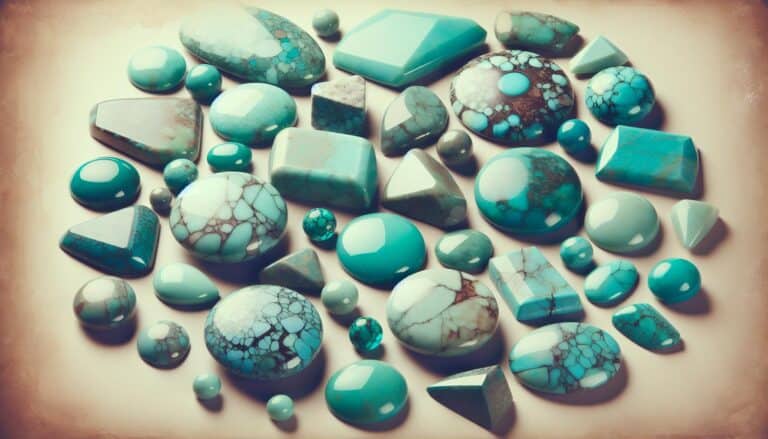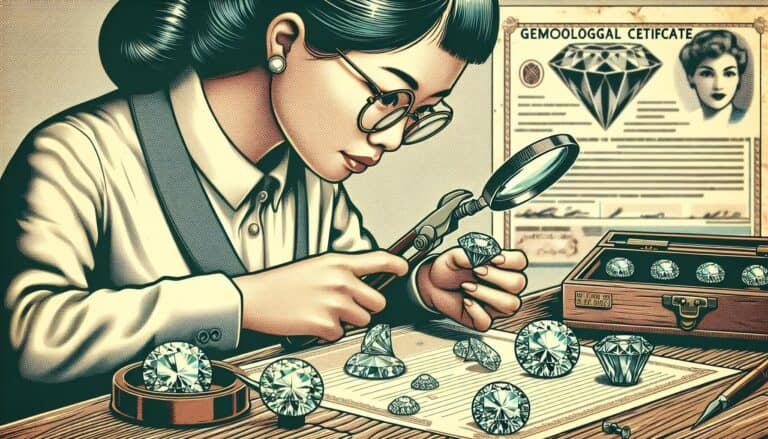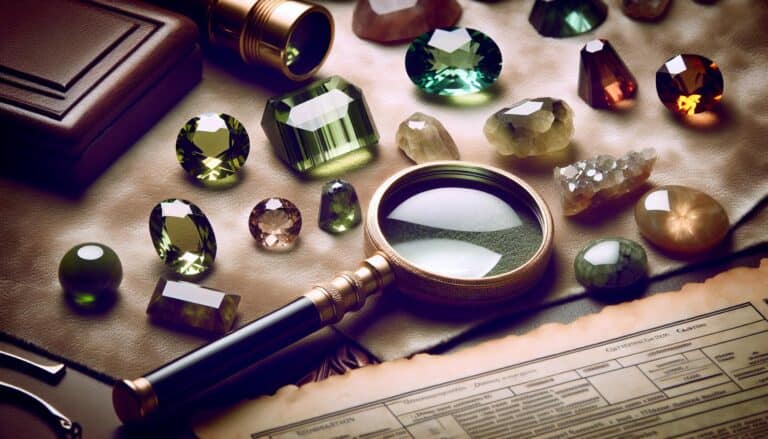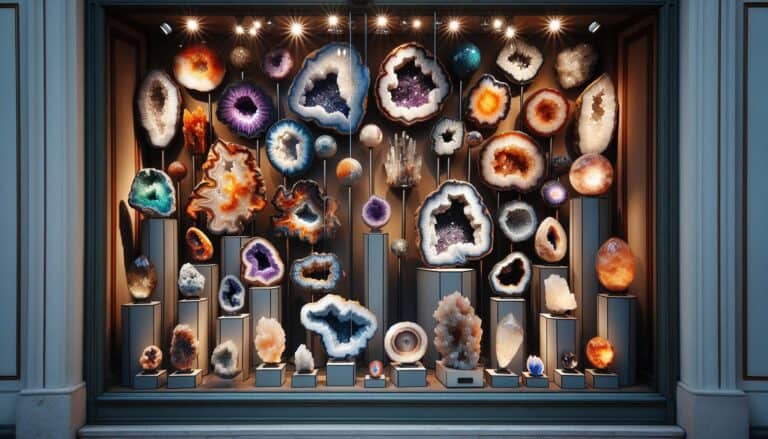Discovering the secrets of a true ruby can feel like unlocking a treasure chest.
You’re about to embark on a journey to identify one of the most coveted gems in the world.
Whether you’ve stumbled upon a ruby at a flea market or you’re evaluating a family heirloom, knowing what to look for is key.
To identify genuine rubies, observe their vibrant red color, transparency, and hexagonal structure. True rubies rank 9 on the Mohs scale, show natural inclusions, are double refractive with a refractive index of 1.76-1.78, and have a specific gravity of about 4.00.
How to Identify Ruby Through Testing
When you’re on the hunt for a true ruby, several tests can help confirm your find. Each test reveals different characteristics of the stone, offering clues to its authenticity.
Visual Inspection
Start with a careful examination of the stone’s color and transparency. Rubies are known for their vibrant red hue, although they can range from almost pink to a deep, pigeon’s blood red. Inclusions, which are natural imperfections, are commonly found in genuine rubies and can assist in distinguishing them from synthetics.
The Streak Test
A simple yet effective method, the streak test can reveal the true nature of your ruby. Dragging the stone across an unglazed porcelain tile should leave a red streak; fake stones will leave no streak or a colored trail inconsistent with genuine ruby.
Magnet Test
While rubies aren’t naturally magnetic, impurities within the stone, like iron, could respond to a magnet. If your stone is slightly magnetic, it may still be a real ruby, but further tests are necessary to confirm.
Hardness Test
Rubies are one of the hardest gemstones, ranking a 9 on the Mohs scale. Gently scraping your stone against an item of a known hardness can indicate where it sits on the scale. Keep in mind that performing this test might damage the stone, so it’s not always recommended.
Birefringence Test
Rubies exhibit birefringence, meaning they refract light into two separate paths. When viewed through a lens, if the stone shows a double image, it is displaying birefringence, which authentic rubies possess.
Checking The Diaphaneity
Observe the stone against light to check its diaphaneity, or how it transmits light. A real ruby should allow some light to pass through, indicating its translucency.
Single or Double Refraction
Rubies are double refractive, which means they bend light twice as it passes through the stone. This effect can sometimes be seen with the naked eye but is more often observed under a jeweler’s loupe.
Refractive Index Test
Professional tools like a refractometer measure the refractive index of a gemstone. A true ruby’s refractive index ranges from 1.76 to 1.78. This precise measurement provides a strong indication of authenticity.
Finding The Specific Gravity
Weigh your stone in air and then in water to determine its specific gravity. Real rubies have a specific gravity of approximately 4.00, which distinguishes them from look-alikes and synthetics.
Identifying Rubies in the Field
When you’re searching for rubies in their natural environment, look for tell-tale signs like a hexagonal crystal shape and glass-like luster. Rubies typically form in marble or basalt, which guides the areas to search.
Recognizing Potential Ruby Rocks
Not all rubies are immediately identifiable by the naked eye. Sometimes, potential ruby rocks may have a dull appearance due to the rough exterior. Look for red hints or consider the geological context of where the stone was found to evaluate its potential.
Star Ruby vs Ruby
Star Ruby and Ruby, two captivating gemstones, each possess their own unique charm. Star Ruby is a rarity that displays a mesmerizing optical phenomenon called asterism. When illuminated, a star-like pattern with six rays appears on its surface, created by the presence of rutile needle inclusions. This celestial effect sets Star Ruby apart, enchanting admirers with its ethereal beauty.
Ruby, on the other hand, is renowned for its rich red hue, representing love and passion. Unlike Star Ruby, it does not showcase asterism but dazzles with its vibrant color and brilliance. Rubies have a long history of being cherished gemstones, symbolizing strength and vitality. Their deep red allure and exceptional durability have made them a popular choice for jewelry, especially engagement rings, where they symbolize enduring love and commitment. Whether it’s the starry allure of a Star Ruby or the fiery passion of a Ruby, both gemstones hold a special place in the world of precious stones.
Physical Characteristics of Ruby

Rubies are appreciated worldwide for their vivid red hue and dazzling luster, which can vary from pink to a deep, pigeon blood red. This color stems from chromium, a trace element that infiltrates the mineral corundum, the base substance of a ruby. You’ll often find that the color saturation is one of the most telling characteristics when you’re trying to identify a true ruby. The more intense and uniform the color, the higher its value and authenticity.
Beyond color, rubies are also exceptionally hard, ranking 9 on the Mohs scale, making them the second hardest natural gemstone right after diamonds. This hardness not only contributes to their desirability for jewelry but also provides you with a practical method for testing a suspected ruby. An authentic ruby can scratch glass and softer gemstones easily.
To further examine a ruby’s authenticity, inspect its crystal habit. Typically, natural rubies form in hexagonal prisms and plates. A close observation might reveal these geometric patterns. Remember, synthetic rubies may mimic these shapes, so it’s critical to combine this with the other tests mentioned earlier.
Transparency in rubies can range from opaque to transparent, but most high-quality gemstones lean towards being semi-transparent. Keep in mind that inclusions are common in rubies and can take the form of silk (fine needles), crystals, or a combination of both. While inclusions often reduce the value of other gemstones, they can actually indicate that a ruby is natural as opposed to a too-perfect synthetic lookalike.
Consider the specific gravity of a ruby, typically between 3.97 and 4.05. This measurement will help differentiate a true ruby from similarly colored imposters, such as garnets or tourmalines, which have different densities.
| Gemstone | Specific Gravity Range |
|---|---|
| Ruby | 3.97 – 4.05 |
| Garnet | 3.61 – 4.3 |
| Tourmaline | 3.06 – 3.25 |
How Are Rubies Formed?
Rubies owe their existence to a dynamic process deep within the Earth’s crust. Your understanding of these gorgeous gemstones isn’t complete until you grasp the mechanisms behind their formation. Rubies are born in an environment rich in aluminum oxide, under high pressure and temperature conditions that would easily shatter less resilient materials.
The presence of the element chromium is crucial—it’s the chromium that gives rubies their signature red color. Corundum is the crystalline form of aluminum oxide and is colorless by itself. Only when chromium is also present does it transform into the red treasure that’s captivated humans for millennia.
This formation process commonly occurs in marble or basalt, which provide the necessary aluminum, but it’s the geological activities, like plate tectonics and mountain formation, that facilitate the heat and pressure needed. Inclusions, often perceived as flaws, are actually evidence of the ruby’s tumultuous creation story. These tiny imperfections bear witness to the intense circumstances of pressure and heat that the gemstone underwent.
Rubies can take millions of years to form, with most of the commercially available stones being hundreds of millions of years old. As you delve deeper into their origins, you’ll find that each stone’s journey to becoming a ruby is as unique as its hue and luster.
Preparation for Ruby Hunting
When you’re gearing up for a ruby hunt, it’s critical to prepare adequately to maximize your chances of success. Knowing the formation process of these precious stones will guide you in the right direction, but there’s more to ruby hunting than just scouting the landscape.
Gathering the Right Tools
First things first, you’ll need the right tools for the job. Here’s what should be in your toolkit:
- Geologist’s hammer: To break apart rocks and extract potential ruby samples.
- Chisel and gloves: For precise work and hand protection.
- Magnifying glass or jeweler’s loupe: To inspect rocks for ruby inclusions.
- Durable backpack: To carry your tools and any ruby finds.
Ensure each tool is fit for purpose. For instance, a jeweler’s loupe should offer a magnification of at least 10x to identify the ruby inclusions which testify to their high-pressure, high-temperature birth.
Safety Considerations
Ruby hunting can pose some risks, so it’s paramount to prioritize safety:
- Wear safety gear: This includes a hard hat, safety goggles, and a pair of sturdy boots.
- Be aware of your environment: Whether you’re in a marble or basalt deposit area, familiarize yourself with potential geological hazards.
- Stay hydrated and protected: Always bring enough water and wear sunscreen.
- Inform someone about your plans: It’s smart to let a friend or family member know where you’ll be and when you plan to return.
Remember, while rubies can be found in a variety of geological settings due to the intense geological activities like plate tectonics, not all red stones are rubies. Keep your guidebook handy to help distinguish true rubies from other minerals.
Handling and Care of Found Rubies

After you’ve successfully located and retrieved rubys from their natural habitat, it’s paramount to handle and care for them correctly. Proper maintenance not only preserves their luster and appeal but also protects their value. Here’s how you can keep your newly found treasures in pristine condition.
Cleaning and Storing
Freshly mined rubys may be covered in dirt and debris. You’ll want to clean them carefully to avoid scratching their surfaces. Start by using a soft brush to gently remove any loose particles. Subsequently, you can wash them in a solution of mild soap and warm water, using the brush to lightly scrub them. Rinse the rubys thoroughly to ensure all soap residue is removed.
Once your rubys are clean, pat them dry with a soft cloth. It’s important to remember that though rubys rank high on the hardness scale, they are still susceptible to chips and fractures from sharp impacts. When it’s time to store your rubys, consider the following:
- Wrap each ruby individually in a soft cloth or place it in a fabric-lined box to prevent them from scratching each other.
- Keep your rubys away from extreme temperatures and sudden temperature changes which can cause cracking.
- Avoid storing them near chemicals like household cleaners or cosmetics that may tarnish or damage their appearance.
By meticulously cleaning and storing your rubys, they’ll remain brilliant and striking for years to come. Remember to revisit these steps every time you return from your search to ensure your precious stones retain their natural beauty.
Conclusion: Confirming Your Ruby is Real
You’ve now got the know-how to identify a real ruby.
Remember, the key is in the details—from color to hardness and light reflection. When you come across a potential ruby, use these insights to confirm its authenticity. Don’t forget to care for your gem; proper cleaning and storage are vital to maintain its brilliance. Cherish your ruby’s timeless beauty and enjoy the pride that comes with discovering this precious stone.
Whether for personal enjoyment or as an addition to a collection, your ruby is a treasure to be valued.







